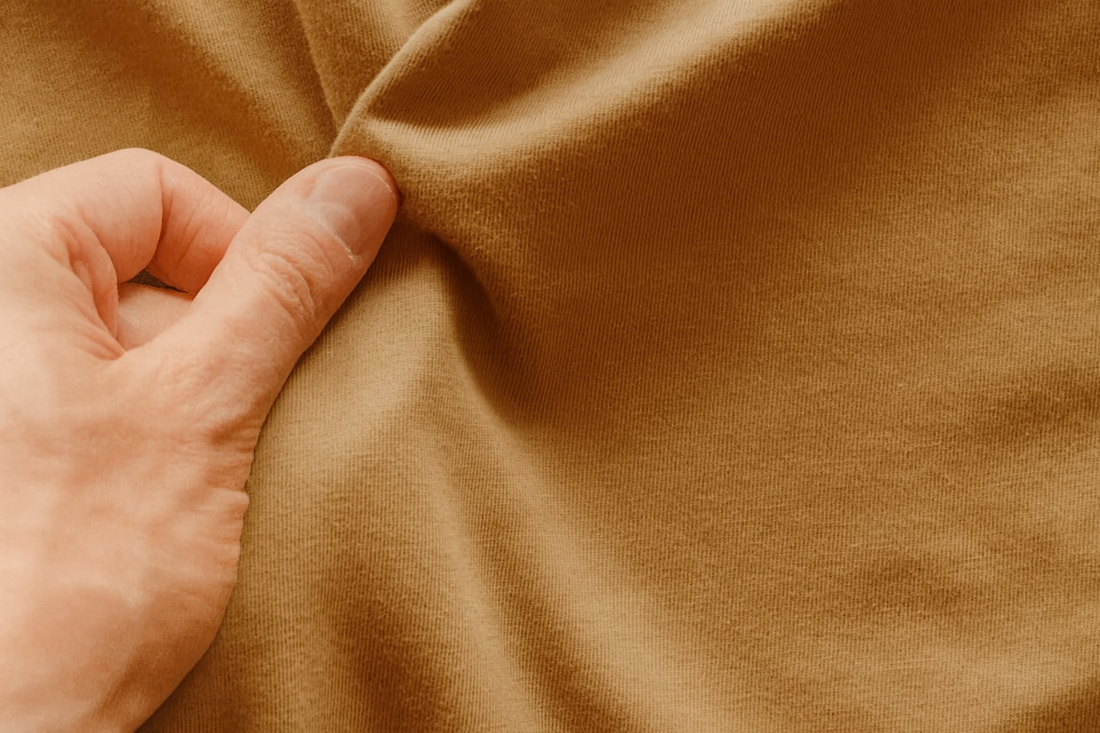
The Best Fabric Blends for Unisex T-Shirts in Active Lifestyles | Coffee Fitness Life
Share
Active lifestyles demand more from a t-shirt than most people realize. You need comfort during your workout, breathability for your coffee run, and durability that holds up after countless washes. The wrong fabric can leave you sweaty, wrinkled, or just plain uncomfortable.
At Coffee Fitness Life, we believe apparel should do more than cover your body; it should fuel your movement, mindfulness, and connection. That’s why we’ve built our unisex t-shirts around the best fabric blends for people who juggle workouts, coffee breaks, and community in one busy day.
Key Takeaways
- Blends beat single fabrics for durability, comfort, and easy care.
- Wrinkle-resistant blends save time for people on the go.
- Cotton blends are breathable and versatile, while linen cotton blends are perfect for summer coolness.
- Tri-blends and spandex fabrics bring softness, stretch, and sweat control.
- Coffee Fitness Life merges positive vibes coffee slogan shirts with unisex gym and yoga graphic tees that reflect both style and performance.

Fabric Fundamentals: Weight and Thread Count
Fabric weight (GSM) tells you how light or heavy a t-shirt feels:
- Lightweight (120–150 GSM) → airy, soft, great for summer workouts.
- Medium weight (160–180 GSM) → balanced, versatile for everyday unisex wear.
- Heavyweight (200+ GSM) → durable, structured, better for cooler climates.

Thread count (yarn size) affects softness and smoothness. Higher thread counts = softer and finer, but too high can reduce breathability. For activewear, blends usually sit at the sweet spot: soft yet resilient.
Decision Factors for Choosing Active T-Shirts
When picking a unisex tee for an active lifestyle, think about:
- Comfort – softness against skin matters for all-day wear.
- Durability – can it handle workouts, washes, and daily movement?
- Moisture Management – does it wick sweat or trap it?
- Wrinkle Resistance – do you want an easy-care fabric t-shirt?
- Breathability – especially for gym, yoga, or mindfulness apparel.
- Style – the right drape and stretch for positive vibes graphic shirts that look as good as they feel.
Fabric-by-Fabric Deep Dive
1. Cotton Blend Fabric
- Pros: Soft, breathable, affordable, great print surface.
- Cons: 100% cotton wrinkles and shrinks; blends fix that.
- Subtypes: Ring-spun (softer), combed (smoother), organic cotton (eco-friendly), Pima/Egyptian (luxury).
- Best for: Everyday wear, slogan shirts, and mindfulness apparel. A style like the Don’t Stop Unisex T-shirt shows how cotton blends balance softness with resilience.
2. Linen Cotton Blend Fabric
- Pros: Naturally cooling, breathable, moisture-wicking.
- Cons: Wrinkles easily, needs care, higher price.
- Best for: Summer workouts, yoga, and casual coffee catch-ups.
- Bonus: Summer workouts, yoga, and casual coffee catch-ups. Linen blends offer a relaxed feel and steady airflow, softening with each wash.
3. Polyester Blends
- Pros: Wrinkle-resistant, quick-dry, holds shape, perfect for sweat sessions.
- Cons: Less breathable if not blended; static in dry climates.
- Best for: Gym tees, high-intensity fitness apparel, sublimated prints.
4. Tri-Blends (Cotton, Polyester, Rayon)
- Pros: Ultra-soft, drapes beautifully, moisture-wicking.
- Cons: Can be thinner, slightly higher price.
- Best for: Unisex gym and yoga graphic tees; a balanced mix of performance and comfort seen in mindful designs like the Life Love Yoga” unisex t-shirt, where tri-blend softness and easy drape support flow and all-day wear.
5. Cotton-Poly-Spandex Blends
- Pros: Stretch and shape recovery, flexibility, movement-ready.
- Cons: Can trap heat if spandex percentage is too high.
- Best for: Yoga, training, and all-day lifestyle wear.
Quick Fabric Comparison: From Characteristics to Performance
From characteristics to performance, fabrics aren’t all made the same. Check out this handy table to see how cotton, polyester, and tri-blend shirts stack up where it really counts.
|
Fabric |
Overview |
Types |
Benefits |
Drawbacks |
|
Cotton |
Classic choice, known for comfort and breathability |
Egyptian, Pima, Supima |
|
|
|
Polyester |
High-performance synthetic |
Single type |
|
|
|
Cotton-Poly |
Blend of comfort + durability |
Cotton-polyester |
|
|
|
Cotton-Rayon |
Blend with classy drape, smooth feel |
Cotton-rayon |
|
|
|
Tri-blend |
Ultimate comfort + performance |
Cotton, polyester, rayon |
|
|
Blends and Ratios: What Works Best?
The magic lies in the mix. Popular active t-shirt ratios include:

- 80/20 Polyester-Cotton → soft, durable, moisture-resistant.
- 65/35 Poly-Cotton → breathability with quick-dry durability.
- 50/50 Cotton-Poly → balanced softness and wrinkle resistance.
- Tri-blend (50/25/25) → comfort + drape + sweat control.
- 95/5 Cotton-Spandex → everyday comfort with flexibility.
These ratios are common across activewear, and they’re well represented in the range of unisex t-shirts, where fabrics are chosen to match real movement and daily versatility.
Practical Guidance: The Business & Lifestyle Angle
For our community, fabric isn’t a detail it’s the whole experience. We know our customers want easy-care fabric t-shirts that can handle sweat, stretch, and style. That’s why Coffee Fitness Life designs focus on:
- Wrinkle-resistant blends for less ironing.
- Moisture-wicking fibers for gym-to-street wear.
- Positive Vibes designs that inspire, whether you’re at yoga or grabbing cold brew.
This balance of performance and personality sets our brand apart. You don’t just wear a shirt you live your lifestyle in it.
FAQs
Which type of fabric is best for shirts?
- Cotton is soft and breathable.
- Linen is cooling in hot weather.
- Polyester blends are durable and wrinkle-resistant.
- For activewear, blends are usually best.
Is 100% cotton the best for a shirt?
- It’s soft, natural, and comfortable.
- But it wrinkles and shrinks.
- Blends make t-shirts easier to care for.
What is the highest-quality cotton for shirts?
- Pima and Egyptian cotton – luxury, soft, durable.
- Combed ring-spun cotton – smooth and strong.
- All three resist fading and feel premium.
What are high-quality t-shirts made of?
- Ring-spun or organic cotton.
- Cotton-poly or tri-blends for performance.
- Sustainable options like linen.
What is the coolest fabric for shirts?
If your priority is staying cool in summer, go with natural, breathable fibers. Linen and bamboo are your best friends, while cotton and Tencel are also solid warm-weather picks.
|
Fabric |
Cooling Effect |
Breathability |
|
Linen |
Highest |
Excellent |
|
Bamboo |
Very High |
Excellent |
|
Cotton |
High |
Very Good |
|
Tencel |
High |
Very Good |
Why choose fabric blends over single fabrics?
- Blends reduce wrinkles.
- They add stretch.
- Better sweat control and durability.
What fabric blend is best for moisture-wicking?
For workouts and high-sweat sessions, synthetics take the crown. Polyester blends wick moisture away fastest, while cotton-poly blends balance dryness with softness. Bamboo is a nice natural option for casual movement.
|
Activity Type |
Recommended Fabric |
|
High-intensity |
Polyester Blends |
|
Moderate-intensity |
Cotton-Poly Blends |
|
Casual Exercise |
Cotton, Bamboo |
Cotton-poly vs. tri-blend: which is better for unisex t-shirts?
- Cotton-poly → more durable, wrinkle-resistant.
- Tri-blend → softer, better drape, lifestyle appeal.
- The choice depends on style vs. durability.
Are spandex blends good for active t-shirts?
- Yes, spandex adds stretch.
- Keeps shape after workouts.
- Perfect for yoga and training.
Do blends improve breathability and sweat control?
- Yes, cotton-poly improves airflow.
- Polyester helps wick sweat.
- Tri-blends balance comfort and performance.
